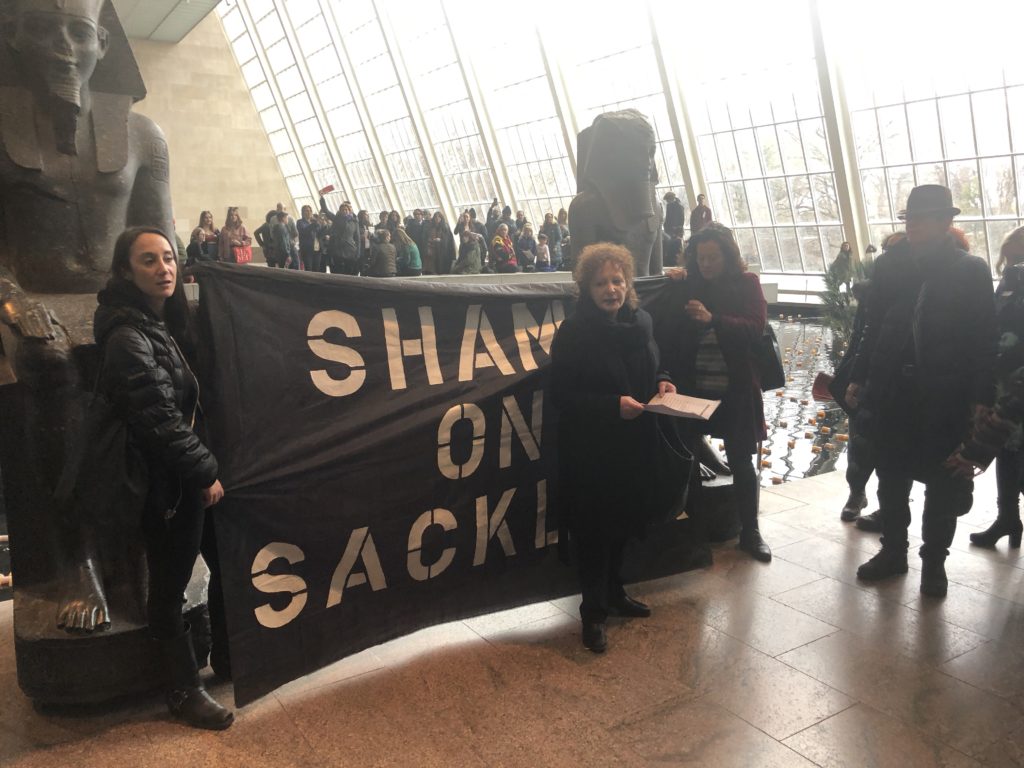
The Sacklers are best known as patrons of the arts, including the Sackler Wing of the Metropolitan Museum in New York with its Temple of Dendur, and the Sackler Gallery, the national museum of Asian art at the Smithsonian. Over the years, the family’s generosity has been noteworthy in areas like education and medicine as well.
More recently, the family has become almost as well known as the principle shareholders of Purdue Pharma LP, the manufacturer of OxyContin. Their business endeavors have made them the subject of multiple legal actions claiming that the company’s aggressive marketing has helped to produce the nation’s opioid epidemic. Purdue Pharma has helped the family to build the fortune it’s been using in its philanthropy. In 2016, Forbes estimated the family’s wealth at $13 billion. Since it was introduced to the pubic in 1995, OxyContin has reportedly generated more than $35 billion in revenues for the company.
A spokesman for the Sachler family responded to the OxyContin-dirty money allegations that were made in a Massachusetts lawsuit as follows:
For more than half a century, several generations of Sacklers have supported respected institutions that play crucial roles in health, research, education, the arts and the humanities. It has s been a privilege to support the vital work of these organizations and we remain dedicated to doing so. While plaintiffs’ court filings have created an erroneous picture and resulted in unwarranted criticism, we remain committed to playing a substantive role in addressing this complex public health crisis. Our hearts go out to those affected by drug abuse or addiction.
In their statement, the family places the allegations of predatory business behavior in the context of their longstanding generosity—asking us to give them the benefit of the doubt given all the good they have done. An article in Esquire at the time was far less forgiving:
the family’s leaders have pulled off three of the great marketing triumphs of the modern era: The first is selling Oxycontin; the second is promoting the Sackler name; and the third is ensuring that, as far as the public is aware, the first and second have nothing to do with one another.
Given the high emotions around the “deaths of despair” that are associated with opioid addiction–and the overuse of OxyContin in particular–it is easy to join activists and many in the press who have condemned the Sacklers before they’ve had their day in court. After all, no one forced doctors to prescribe these painkillers or anyone down the line to take them. But this story does raise some broader questions, including:
– How often is philanthropy (and the moral afterglow of generosity) a cover for wealth that wasn’t earned in nearly as moral a way?
– What might the givers and the receivers in this situation have done differently?
– Since “generosity born of success” always seems to come with the suspicion that you’re “dressing-up the road that got you here,” how can gifts like the Sacklers ever hope to match their best intentions?
– And beyond philanthropy, what responsibilities should all receivers and givers—including you and me—have in supposedly “generous exchanges”?
1. The Toxic Givers

Nothing about these questions is easy.
For example, some members of the Sackler family have no financial interest in Perdue Pharma, the opioid manufacturer, although it has been argued that marketing strategies pioneered by the family patriarch utlimately drove OxyContin’s success. Some of the Perdue profits that did go to Sacklers were attributable to other products or were produced before the opioid painkiller entered the market. Linking particular individuals to toxic profits that then went into specific gift giving is a complicated question of attribution. In fact, it is a problem for all philanthropy that may have toxic origins. How do you know that the donated Picasso was purchased with a philanthropist’s dirty money?
In the case of the Sacklers, it seems clear from an Inside Philanthropy piece last year that at least some of their OxyContin profits likely became gifts to organizations as diverse as Tufts University’s School of Biomedical Sciences, New York Presbyterian Hospital, the Central Park Conservancy, the Guggenheim and Victoria & Albert museums, and the National Academies of Sciences, Engineering and Medicine (which the U.S. Food and Drug Administration relies upon for independent scientific advice on issues like opioid addiction).
While the Sackler Wing of the Metropolitan Museum of Art in New York City was funded long before OxyContin came to market, it continues to bear the family name and has been at the epicenter of protests against the family’s toxic giving.

It’s a thorny path from here for the givers as well as the receivers.
For givers like the Sacklers, a couple of avenues are clear to me at least, but neither seems to have been taken by individual family members to date. The first is new philanthropy aimed at opioid addiction treatment, a need that remains woefully underfunded nationwide. Maybe in a strange twist of public relations and legal advice, family members are waiting for a court to tell them what to do instead of making up their own minds.
The second road-not-taken is any suggestion that Purdue Pharma is curtailing its global roll-out of OxyContin. According to a 2017 New Yorker article that helped to trigger the current outrage: “the Sackler family has only increased its efforts abroad, and is now pushing the drug, through a Purdue-related company called Mundipharma, into Asia, Latin America and the Middle East.” Again, the better part of valor would suggest that the company should be reducing, instead of expanding its marketing outreach for this painkiller—even if its marketers and lawyers are advising that to do so could be construed as a kind of admission of liability.
For receivers like the supposedly independent government bodies that play a role in regulating opioids, the answer also seems clear. They should disclose how OxyContin-related donations were used by them in the past, modify standards that permitted receipt of donations by interested parties in the first place, and refuse to take any additional donations from them.
For other receivers of Purdue Pharma related largesse, the issue is complicated by two additional factors: how desperate many (most?) non-profits are to reach their fund-raising goals each year, and how nearly all significant gifts and naming rights are bound up in legal agreements.
Even if the public or moral pressure were enough to make reluctant institutions consider returning toxic funds, in most situations the donors would need to voluntarily agree to take their money back or to removal of their names from programs or buildings. Whenever the givers demur or outright refuse, the receivers need to convince a court that they have the right to unwind the gift agreement unilaterally. In addition to the preoccupation and expense of a legal proceeding like this, the non-profit might also have to prove that the donors were personally responsible in some way for their gift’s toxicity (the attribution issue again). According to Marcus Owens, former director of the IRS’ tax exempt organization’s division:
For the institutions, it’s a real balancing act where there hasn’t been an actual conviction of a crime and it’s more that the donors have done something that is optically troubling to the recipient.
While there has been litigation involving Perdue Pharma and OxyContin, no court to date has tied its toxic marketing to any individual member of the Sackler family, despite the fact that several are in senior management or board members.
Given all of the brouhaha, I assume that institutions that stand to gain from future Sackler donations are considering the risks of acceptance before they do so. But even here, the path regarding toxic gifts that have already been given or may be given in the future is far from clear. Some insist the amount of good that tainted money can do when invested in a school or museum offsets whether it was made in a deplorable fashion or was given by a deplorable individual. Even if you buy the argument that the ends justify the means, the 24-7 social-media environment makes every receivers’ reputation a key factor in the calculation of ultimate ends .
While the opioid crisis has thrown Sackler family philanthropy into bold relief, the moral debate today is hardly confined to individuals who are trying to launder their unclean profits by giving money to prominent institutions.
On this page, I’ve briefly considered whether living artists (like Chuck Close who was accused of victimizing his female models) should have existing art they have given to museums taken down and new art they are creating boycotted by collectors. I’ve discussed Anand Giridharadas contention in Winners Take All: the Elite Charade of Changing the World (2018) that Silicon Valley tech companies like Facebook are using their philanthropy as a rationale for “us liking them” however much they are also causing us harm. As Giridharadas said at the time:
What I started to realize was that giving had become the wingman of taking. Generosity had become the wingman of injustice. ‘Changing the world’ had become the wingman of rigging the system…[L]ook at Andrew Carnegie’s essay ‘Wealth.’ We’re now living in a world created by the intellectual framework he laid out: extreme taking, followed by and justified by extreme giving.
It sounds a lot like what the Sacklers are being accused of today.
There is also the complicated moral dynamic between individual givers and institutional receivers when it comes to sources of information and the reporting of that information by the press. Media outlets eager to capture audiences with breaking news usually have little time to consider either the truth of the story their source has brought them or the bias and other hidden motivations that could undermine it after publication. When lapses in this kind of giving-and-receiving occur, the implications are wide-ranging because they tend to erode the press’s general reputation for truth telling.
Consider too the prominent individuals who may have been too quick to believe the story that Jessie Smolett gave to the media about a racist and homophobic attack in Chicago—and if it turns out to be false—how the breakdown in that exchange could call into question the veracity of everyone who claims they were victimized by a hate crime going forward.
Giving nearly anything that has value to an institution today (be it a donation, a work of art, or even an interesting story) can easily become a morally fraught transaction.
2. Giving and Taking One-on-One
I started this post with a picture of a sculpture from prehistory that conveys—to me, at least—the openness of giving. The bad news is that generosity is rarely this simple, pure or beautiful.
Generosity towards others is the key corrective for acting on our own behalf. Whenever we act, we try to be mindful of how that act impacts us as well as others. In autonomous exchanges, we strive to realize the best we have to offer while having the generosity to respect the same kind of striving in others. The aim is reciprocity in how we treat ourselves and others and how we hope that others will treat us in return.
Of course, problems arise in life and work when any part of this exchange become unbalanced, but it seems to me that far more attention is spent on the imbalances caused by selfishness than on those that are caused by generosity.
Not unlike a wealthy family bearing much-needed gifts for a non-profit or a source dangling a juicy story before a ravenous press, giving can foist significant burdens on the receiver or mask a giver’s less than noble motivations. These pitfalls seems equally likely in our exchanges with one another.
For example, it’s easy to be ravished by someone’s seemingly spontaneous generosity, until you’ve been singed by it. A stranger offering you a trinket when he’s looking for a hand-out makes you reluctant to take anything that’s being handed to you when you’re walking down the street. But what if they are items with real value, graciously offered, and part of you wants to accept them? This happened to me while I was traveling recently and unfamiliar with the local customs. It was only later that I discovered what was expected of me in return and could safely provide it…but not before I felt the burden of indebtedness born of generosity.
To return to the Sacklers for a minute, there may have been several motivations behind their gift-giving, but at least where philanthropy and random acts of kindness are concerned, such motivations become irrelevant whenever the giver gives anonymously. Unfortunately, among lovers, friends, neighbors, co-workers, bosses, employees and (when in Rome) strangers on the street, anonymity is simply impossible.
In our personal relationships, we’d prefer not to focus on the ledger balances between us most of the time. Rough reciprocity in what we give to and take from one another will usually suffice. But losing sight of these balances altogether can weaken and even jeopardize those same relationships. Overly generous givers can feel depleted and exploited by others’ needs. Givers who use their generosity to gain others’ approval can be oblivious to the burdens their giving places on receivers to reciprocate. The needs and motivations at play are as relevant when we give to one another as they are in the seemly less personal world of philanthropy.
There simply aren’t many rules of thumb here, but maybe Khalil Gibran (that Siddhartha for hippies) came closest to providing one:
“Generosity is not giving me that which I need more than you do, but it is giving me that which you need more than I do.”
This post was adapted from my February 24, 2019 newsletter.











